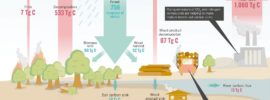Editor’s Note: In a three-part series concluding today, Treesource is exploring the potential roles of forests and wood products in addressing the global climate crisis.
Part 1 (Read it here): How can we use more wood, a renewable, biodegradable carbon sink, while also storing more carbon in forests across the U.S. and the world?
Part 2 (Read it here): What incentives and regulations are needed for landowners, forest stewards, corporations, governments and NGOs to change their practices and thereby make carbon storage a top priority?
Part 3 (Today) A look ahead to 2050. What could a more sustainable society look like, if forests and wood products were utilized in new and more effective ways?

Imagine stepping out of a time machine in June 2050 — and finding yourself atop a 28-story, mass-timber building perched amidst a forest of high-rises on Chicago’s South Side.
Except for the Windy City’s rather brisk breeze, you find the panorama provocative, remarkable, intriguing: You can see many of the city’s neighborhoods, distinguished by crowns of trees planted in the 2020s and 2030s. Living roofs and skywalks connect buildings while Chicagoans picnic under the greenery and walk their dogs. Cyclists pedal their ways to work or home, or maybe shopping.
The mayor greets you, as do the governor and the president standing next to him. They have come to celebrate a long-hoped-for achievement: This year, finally, the world has recorded a decrease in atmospheric CO2. Such celebrations are under way worldwide.


